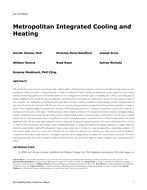Description
The potential for recovery and reuse of waste heat from cooling London’s underground train tunnels as a heat source for district heating systems has been investigated. Cooling of London’s underground system is needed to maintain the future underground environment at safe temperature levels. Cooling methods currently being applied across the network include the use of cooling coils in ventilation shafts, air handling units (AHUs) and cooling pipes in tunnels, although the latter method has only been applied on a theoretical basis. These systems use chilled water to cool the air in the tunnels by means of heat exchangers. The chilled water is normally generated using chillers and heat is rejected to atmosphere. District heating networks currently account for only about 2% of total heat used in the UK. However, there are a number of local government managed district heating schemes operating in London, at present. Heat is generally supplied by combined heat and power (CHP) generating plant, but it is planned to expand these schemes and to make use of secondary waste heat sources in the future. The present project, which is funded by Innovate UK, investigates the potential benefits of combining cooling of London’s underground train tunnels with the transfer of heat to district heating networks. Instead of using air cooled chillers to cool the water to provide cooling to the air in the underground tunnels, it is planned to use water to water heat pumps to transfer the heat to a district heating network. This should significantly reduce the total energy input required for both the cooling and heating of the respective networks. It has been estimated that there is at least 15 MW of waste heat available from cooling London’s underground system. To evaluate the benefits of the proposed approach, an energy, carbon and whole life costing calculator model will be developed to estimate energy, carbon and cost savings for a range of configurations and operating conditions. An inter-seasonal analysis will also be carried out to determine how the benefits vary during the year. Details of the model and the results of preliminary calculations of the potential benefits based on a case study are reported, and the configuration of the planned heat recovery system is presented. The results from the current project will be used to inform the design of a pilot scale trial. This heat recovery approach could be extended to other secondary waste heat sources.
Citation: 2017 Winter Conference, Las Vegas, NV, Conference Papers
Product Details
- Published:
- 2017
- Number of Pages:
- 8
- Units of Measure:
- Dual
- File Size:
- 1 file , 1.3 MB
- Product Code(s):
- D-LV-17-C014




